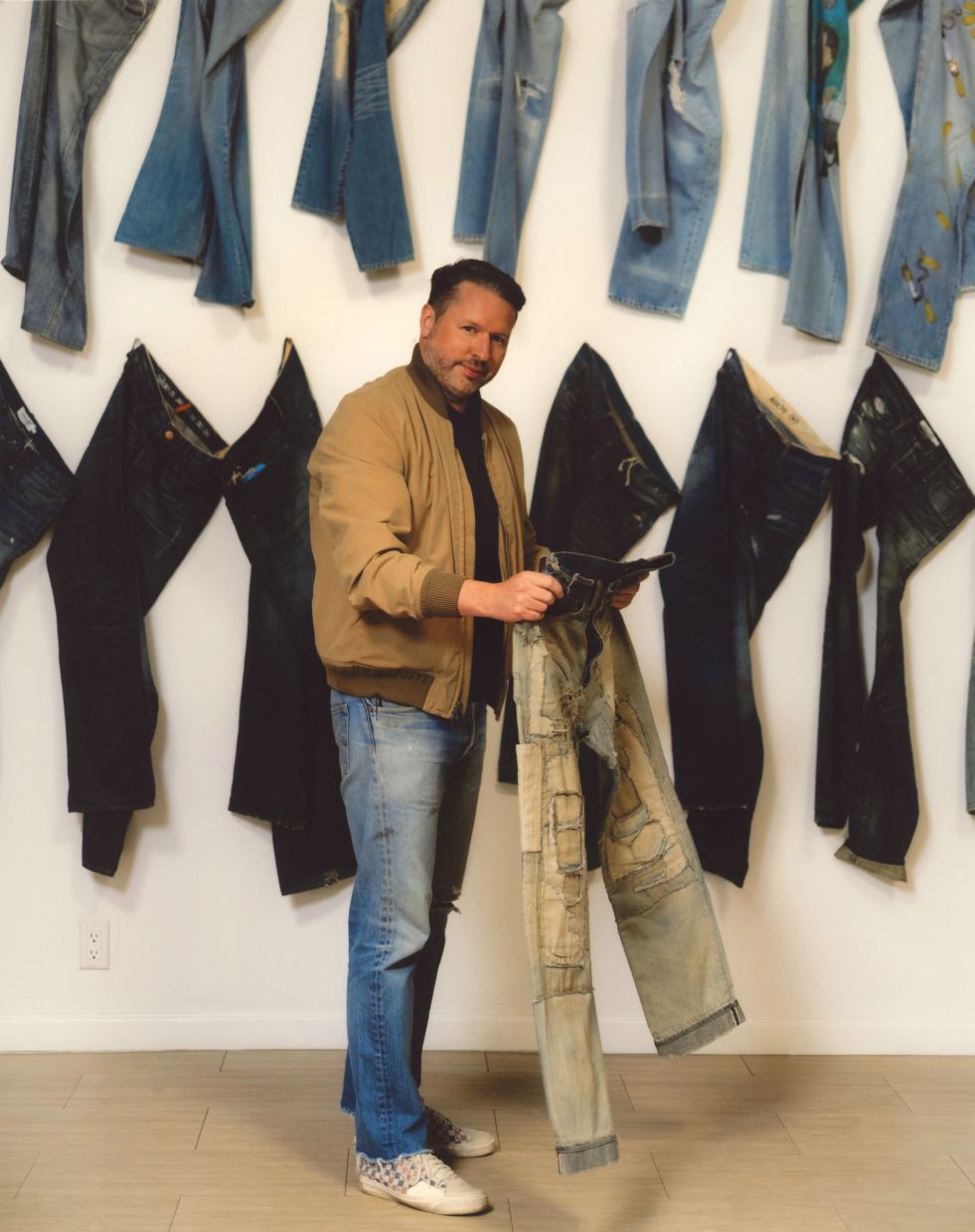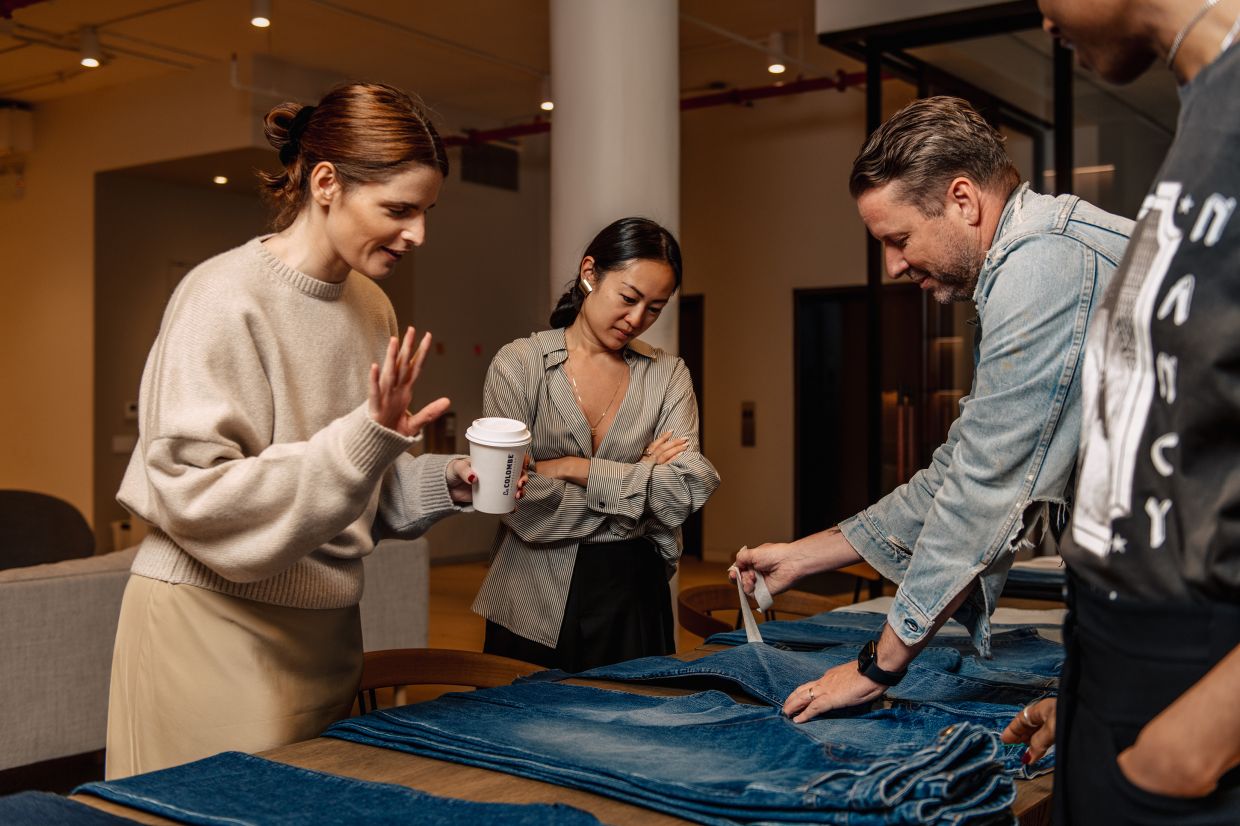If fashion has a man behind the denim curtain – a wizard of jeans – Benjamin Talley Smith is it, a name that’s passed from brand to brand, designer to designer, like a secret password. Photo: The New York Times
One overcast Sunday morning, Benjamin Talley Smith, an apple-cheeked 45-year-old with a thing for a Canadian tuxedo, was at the Rose Bowl flea market near Los Angeles shopping for jeans.
He was wearing jeans – a beat-up pair of Levi’s and an equally worn Levi’s jeans jacket – and rooting through piles of jeans.
He wasn’t looking for collectible jeans, the classics that can fetch thousands, but rather interesting jeans: jeans with an unusual fade or some weird DIY patchwork or a striking paint spatter.
“Every jean is different,” he said with the air of an oenophile assessing a new bouquet.
He was holding up a pair of jeans with some big white patches on the thighs.
“Too acid-washed for me,” he said, putting them back.
He picked up another pair, pointing at a series of faded lines at each ankle.
“See that honeycomb wear pattern?” he said. “That was because some cowboy had his jeans tucked into his boots. I might try to replicate that.”
Then he spied a pair of old jeans from the Japanese brand Evisu.
“Look at that,” he said. He smiled. “I made those.”
Discovering his own work is not an uncommon occurrence for Smith. If fashion has a man behind the denim curtain – a wizard of jeans – he is it, a name that’s passed from brand to brand, designer to designer, like a secret password.
Scott Morrison, one of the founding fathers of premium denim in the US, hired Smith at Earnest Sewn and then introduced him to Catherine Holstein of Khaite, who recommended him to Hali Borenstein of Reformation.
Smith has also worked with Tommy Hilfiger, Alexander Wang, Rag & Bone, Juicy Couture, Helmut Lang, Marc By Marc Jacobs, Vince, Everlane, Aritzia, Jordache and Walmart, for whom he developed its sustainable Free Assembly denim, which starts at US$27 (approximately RM127).
His sweet spot is the place between the jeans behemoths – Levi’s, Lee, Wrangler – and the global luxury groups.
When Holstein met Smith, he was introduced to her, she said, as “maybe the best denim guy in the US”.
He consulted on her bestselling Danielle jeans – the high-waist, straight-leg style made famous by Kendall Jenner, which helped end the jegging boom and set off a quazillion TikTok videos – as well as Reformation’s Val jeans, favoured by Miley Cyrus.
Aside from Khaite and Reformation, Smith is currently working with Ulla Johnson, La Ligne and Spanx (the Spanx being a reinvented denim line that will be rolled out in 2025).
The other week he went to a school interview for his son, and “one of the parents was wearing a full head-to-toe Ulla look I did”, he said.
“A crazy puff-sleeve denim jacket and matching skirt with huge logo buttons,” he said.
“That, to me, is always the most fun,” he added. “I think of the jeans like my children. Whenever I see them, I’m always like, ‘Oh, that’s one of mine.’”
Read more: Despite the fashion stigma, 'double denim' is here to stay as a key trend
The language of jeans
Why does a fashion designer need a denim specialist?
“It’s a completely different language,” Holstein said.
And denim is one of the most perennial of all clothing categories. Once customers discover a style they like, they tend to keep coming back.
That’s why, when Holstein decided to start her business, Smith was the third person she signed up. He likes to call himself the denim whisperer. And she knew she needed someone to speak jeans.
In jeans, “whiskers” does not refer to feline sensory antennae but rather the thin faded lines created by sitting that radiate out at the crotch.
“Ghost patches” are not supernatural; they are light or dark splotches on jeans where patches fell off. “Chevrons” have nothing to do with heraldry but refer to the little puckers down the seams of the inner thigh created when the indigo rubs off.
And “the magic triangle”, a term that is the jeans equivalent of the golden mean, refers to the optimum placement of the back pockets between the yoke and the centre seams.
Get it right, and, according to Smith, it will “make your butt look really good”.
“Mainly in my mind, jeans are about making your butt look really good,” he continued.
“If you place the pockets even a quarter inch too far down on the outer edge, they frown a bit. And then you have a frowny butt. But if you just nudge them up a bit, you get happy butt.”
His job is an endless quest for the platonic happy butt.
For Johnson, who has been working with Smith since late 2020, designing with denim is an entirely different practice from designing with wool, cotton or silk.
“The degree of scientific inquiry that goes into how many hours of wash you need is very, very different from questions of draping,” she said.
But it matters, she said, because though only 5% of her collection is denim, its revenue has doubled since last year.
Then there’s the “shrinkage,” said Borenstein, the CEO of Reformation.
Shrinkage happens during the wash and affects the fit. A regular pair of pants may take a day to make and two or three fittings to perfect.
A pair of jeans, however, takes “a minimum of a week”, she said.
“The points of measure are much more complicated. They have to hug your legs in a lot of different ways.”
Read more: A jean-ius touch? How denim material is taking over fashion again
Denim is eternal
In Los Angeles, which is the heart of the American jeans world and where Smith lives, he has a loftlike office that is sort of a cross between a temple of jeans and a lab of jeans.
The wall behind his desk is hung with 51 different pairs of jeans, arrayed from dark to light, so that whenever he turns his head, he sees jeans. He has racks of jeans and shelves stacked with plastic bins full of jeans organised by wash and brand – “well over 1,000 jeans” in all.
He has the first pair of jeans he ever made, back in 2000, when he was in college, and the most complicated pair of jeans he ever made, for Evisu, which was inspired by an ancient pair of Levi’s and involved so many different aged patches, each of which had to be created by hand, that one pair took two weeks to make and cost US$800 (RM3,756).
“It was not practical,” Smith said.
Smith did not expect to be a denim guy. He grew up in a small town in Vermont, the youngest of five children. His father was a photographer and bookstore owner and ran a printing press; his mother was a schoolteacher and music teacher.
He was “born in a bed that my dad had built”, and generally wore Carhartt.
He didn’t really think about jeans until he got to the Massachusetts College of Art and Design, when he discovered Diesel, and he certainly didn’t plan to make jeans his career – he intended to go into film and interned for Ken Burns, the documentarian – until he decided he wanted to work with his hands and switched to fashion.
A brief stint with a Boston designer took him to Paris, and then, after graduation, he got a job with Tommy Hilfiger.
He was supposed to be working on outerwear, but it was 2003 and premium denim was becoming a thing. Hilfiger needed someone in jeans. Then the executive in charge of denim got sick.
“Basically they were like, ‘You have to do it all,’” Smith said. “I was 25.”
So commenced his odyssey into jeans.
Though Smith dabbled briefly in his own line, called Talley and featuring made-to-order jeans that took about four weeks to produce, he decided he was happier consulting, moving from brand to brand.
“It keeps me nimble to be able to make a US$27 (RM127) jean and then a US$500 (RM2,348) jean,” he said, referring to the Walmart-Khaite divide.
Smith splits his time between the Los Angeles office; his favourite nearby factory, Caitac Garment Processing Inc, which specialises in washes and laser- and hand-sanding (he also works with factories in Pakistan and Turkey); and an apartment in the Greenpoint neighborhood of Brooklyn that he kept because he goes to New York about once a month to see clients.
In Los Angeles, he lives in Studio City, in a ranch-style bungalow built in 1937, with his wife, Danielle Robinson, a co-head of talent at Issa Rae’s ColorCreative management company, and their five-year-old son (Khaite’s Danielle jeans are named in his wife’s honour).
At home, he has 22 pairs of jeans that he actually wears. His wife also has a lot of jeans.
For him, each pair of jeans gives birth to the next pair, which gives birth to the next and so on.
“The wash is like a living, breathing thing,” he said. “It doesn’t always come out the way you want it to, or it leads you in crazy new ways.”
It’s "jeanvolution" in real time.
“I’m never bored,” Smith said.
Whenever he’s in a crowd of strangers, he thinks to himself, I bet I have a jean in your closet. – The New York Times







